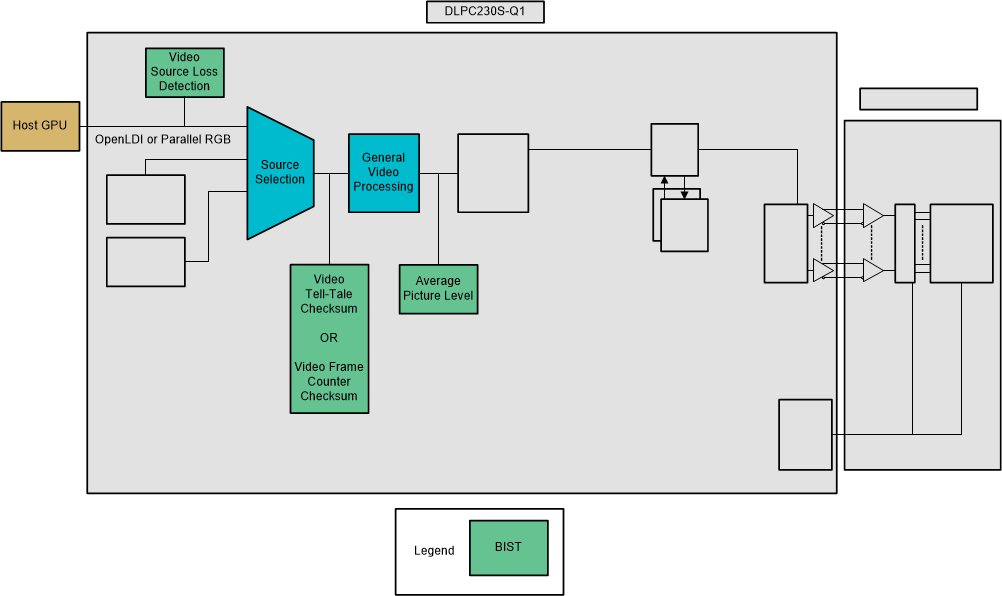DLPU094 July 2020 DLP5530S-Q1
7.3.1.2 Video Input BISTs
Figure 7 gives an overview of BISTs used to monitor the video input.
 Figure 7. Video Input BISTs
Figure 7. Video Input BISTs
- [SM_1] Video Source Loss Detection: Checks if the source of video to the DLPC230S-Q1 has disconnected. It checks the video parameters to make sure they are within acceptable ranges. These parameters are the pixel clock frequency, the VSYNC frequency, the number of active lines per frame, and number of active pixels per line. If the video source is invalid at the initial transition to display mode, no image will be displayed. The system will stay in standby mode. If the source becomes invalid after Display Mode operation, the system will transition to an alternate display image specified in the configuration options—either a test pattern or splash image. In some cases it is possible for the system to auto-recover after a source loss. Auto-recover and alternate source settings can be configured in flash.
- [SM_2] Video Tell-Tale Checksum: Checks the expected video from the host versus the video received by the DLPC230S-Q1. Host MCU provides a checksum for a region of the image, and the DLPC230S-Q1 calculates a checksum over the same region. If the two checksums don't match, the test fails. This checksum can be performed over any rectangular region of the video, including and up to the entire image. However, this test is designed to be used on static or slowly changing portions of the image. The test region of the checksum and the expected checksum can only be changed while the test is disabled. A minimum of two frames is required to disable the test, update the checksum region and/or value, and re-enable the test. The failure action is configurable in flash, but not during operation. Upon test failure, an error can be logged with no additional action, an error can be logged with a change to an alternate source, or an error can be logged and emergency shutdown can be executed. This test cannot be used simultaneously with the Video Frame Counter Checksum.
- [SM_3] Video Frame Counter Checksum: Checks the value of a counter embedded within the video data from the host. If the counter does not increment as expected, the test fails. A subsection of the image can be defined as the counter. The minimum and maximum expected value of this counter is also configurable. Once the counter reaches the maximum, it is expected to roll over and start from the minimum. The counter region can be as small as one pixel and as large as the entire image. HUD images typically have large amounts of unused area in the display area. It is recommended to embed the counter in one of these regions, such as a corner. If the area is sufficiently small, its pixel data can change without being noticeable by the viewer. The failure action is configurable in flash, but not during operation. Upon test failure, an error can be logged with no additional action, an error can be logged with a change to an alternate source, or an error can be logged and emergency shutdown can be executed. This test cannot be used simultaneously with the Video Tell-Tale Checksum
- [SM_4] Average Picture Level: Checks the numerical average of the incoming pixel data. If the average level is higher than the host specified maximum, the test fails. The failure action is configurable during flash build, but not during operation. Upon test failure, only an error can be logged, or an error can be logged and emergency shutdown can be executed.